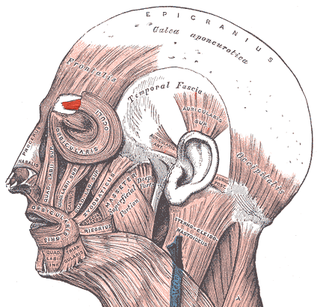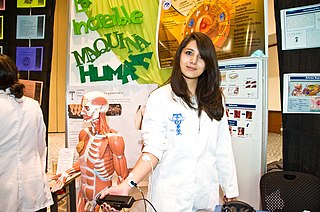Amigdalae is a biofeedback based art project by the artist Massimiliano Peretti. The project has been presented for the first time in a scientific environment at the CNRS, National Center of Scientific Research in Paris, November 2005. This project explores how emotional reactions filter and distort human perception and observation.

Biofeedback is the process of gaining greater awareness of many physiological functions primarily using instruments that provide information on the activity of those same systems, with a goal of being able to manipulate them at will. Some of the processes that can be controlled include brainwaves, muscle tone, skin conductance, heart rate and pain perception. In biofeedback, you are connected to electrical sensors that help you receive information (feedback) about your body (bio).
During the performance, biofeedback medical technology, such as encephalography, body temperature variations, heart rate and galvanic responses, will be used to analyze people's emotional status as they watch video art. Using these signals, the music changes, so that the consequent sound environment will simultaneously mirror and distort the viewer's emotional state.

Electroencephalography (EEG) is an electrophysiological monitoring method to record electrical activity of the brain. It is typically noninvasive, with the electrodes placed along the scalp, although invasive electrodes are sometimes used, as in electrocorticography. EEG measures voltage fluctuations resulting from ionic current within the neurons of the brain. Clinically, EEG refers to the recording of the brain's spontaneous electrical activity over a period of time, as recorded from multiple electrodes placed on the scalp. Diagnostic applications generally focus either on event-related potentials or on the spectral content of EEG. The former investigates potential fluctuations time locked to an event, such as 'stimulus onset' or 'button press'. The latter analyses the type of neural oscillations that can be observed in EEG signals in the frequency domain.
Heart rate is the speed of the heartbeat measured by the number of contractions (beats) of the heart per minute (bpm). The heart rate can vary according to the body's physical needs, including the need to absorb oxygen and excrete carbon dioxide. It is usually equal or close to the pulse measured at any peripheral point. Activities that can provoke change include physical exercise, sleep, anxiety, stress, illness, and ingestion of drugs.

Video art is an art form which relies on using video technology as a visual and audio medium. Video art emerged during the late 1960s as new consumer video technology such as video tape recorders became available outside corporate broadcasting. Video art can take many forms: recordings that are broadcast; installations viewed in galleries or museums; works streamed online, distributed as video tapes, or DVDs; and performances which may incorporate one or more television sets, video monitors, and projections, displaying live or recorded images and sounds.
Technical specifications
In the field of experimental psychology, neuropsychology and psychobiology, the process of tracking and recording cerebrum-cortical electrical activity, and its combination with other values of psychomotor activity, enables the diagnosis of the emotional responses of an individual.
Experimental psychology refers to work done by those who apply experimental methods to psychological study and the processes that underlie it. Experimental psychologists employ human participants and animal subjects to study a great many topics, including sensation & perception, memory, cognition, learning, motivation, emotion; developmental processes, social psychology, and the neural substrates of all of these.
Neuropsychology is the study and characterization of the behavioral modifications that follow a neurological trauma or condition. It is both an experimental and clinical field of psychology that aims to understand how behavior and cognition are influenced by brain functioning and is concerned with the diagnosis and treatment of behavioral and cognitive effects of neurological disorders. Whereas classical neurology focuses on the pathology of the nervous system and classical psychology is largely divorced from it, neuropsychology seeks to discover how the brain correlates with the mind through the study of neurological patients. It thus shares concepts and concerns with neuropsychiatry and with behavioral neurology in general. The term neuropsychology has been applied to lesion studies in humans and animals. It has also been applied in efforts to record electrical activity from individual cells in higher primates.
Psycho-physiological states are assigned to different electrical values. These variations in electrical potential can be recorded with the use of contact electrodes; in most academic situations they are connected to a signal amplifier and an inkjet instrument that reacts to the variations of potential and amplitude of the input data. This instrument, commonly known as electroencephalograph, has been of the utmost importance regarding studies on the functioning of cerebral activity during the awakened state of an individual, the sleeping state, emotional states, and during physiological and psychological disturbances. The recorded data, electroencephalogram, are permanent memories of a distinct period of cerebral activity.

Sleep is a naturally recurring state of mind and body, characterized by altered consciousness, relatively inhibited sensory activity, inhibition of nearly all voluntary muscles, and reduced interactions with surroundings. It is distinguished from wakefulness by a decreased ability to react to stimuli, but more reactive than coma or disorders of consciousness, sleep displaying very different and active brain patterns.
There is other psychophysical data, related to human behaviors, which can be tracked along with variations in brain activity; this data is generally defined as biofeedback.

The brain is an organ that serves as the center of the nervous system in all vertebrate and most invertebrate animals. The brain is located in the head, usually close to the sensory organs for senses such as vision. The brain is the most complex organ in a vertebrate's body. In a human, the cerebral cortex contains approximately 14–16 billion neurons, and the estimated number of neurons in the cerebellum is 55–70 billion. Each neuron is connected by synapses to several thousand other neurons. These neurons communicate with one another by means of long protoplasmic fibers called axons, which carry trains of signal pulses called action potentials to distant parts of the brain or body targeting specific recipient cells.
Crucial elements in the study of psychological states are cardiac frequency, electro muscular activity EMG, and body temperature. Their interpretation gives a detailed response about the psychic activity of an individual.

Electromyography (EMG) is an electrodiagnostic medicine technique for evaluating and recording the electrical activity produced by skeletal muscles. EMG is performed using an instrument called an electromyograph to produce a record called an electromyogram. An electromyograph detects the electric potential generated by muscle cells when these cells are electrically or neurologically activated. The signals can be analyzed to detect medical abnormalities, activation level, or recruitment order, or to analyze the biomechanics of human or animal movement.
- EEG By using an electroencephalograph and a digital interface we can make use of an electrical value, which is output by four sensors placed on the forehead, as a tracking guide of general brain activity. The signals are recorded in real-time and they vary according to psycho-emotional variations in the individual, or according to mutations in the surrounding environment.
The average time for tracking and recording the data is seven minutes. The generated graph is based on a detailed interpretation of the four types of brain waves: alpha, beta, delta and theta. Their values are shown in amplitude (volts), frequency (hertz), and isolated peaks of electrical activity: the amplitude is higher than hundred volts and low in frequency, or short shocks of high frequency waves and small amplitude.
- EMG The electrical muscular response is recorded through the use of a dedicated sensor. Also in this case the signal gets digitized and elaborated by software that defines the thresholds of reaction of the individual and that compares the output data. We take in consideration the area related to facial muscles, particularly the forehead and eyebrows, as they tend to have a more pronounced reaction to emotional activation.
- Cardiac Frequency The heartbeat is recorded through a frequency sensor placed on the index finger of the left hand, and its data is monitored and recorded through the entire duration of the experience.
- Body Temperature A temperature sensor is placed on the palm of the right hand and communicates to the biofeedback machine through the recording of micro thermal variations.
An evoked potential or evoked response is an electrical potential recorded from the nervous system of a human or other animal following presentation of a stimulus, as distinct from spontaneous potentials as detected by electroencephalography (EEG), electromyography (EMG), or other electrophysiologic recording method. Such potentials are useful for electrodiagnosis and monitoring.

In the broadest definition, a sensor is a device, module, or subsystem whose purpose is to detect events or changes in its environment and send the information to other electronics, frequently a computer processor. A sensor is always used with other electronics.
Electrodermal activity (EDA) is the property of the human body that causes continuous variation in the electrical characteristics of the skin. Historically, EDA has also been known as skin conductance, galvanic skin response (GSR), electrodermal response (EDR), psychogalvanic reflex (PGR), skin conductance response (SCR), sympathetic skin response (SSR) and skin conductance level (SCL). The long history of research into the active and passive electrical properties of the skin by a variety of disciplines has resulted in an excess of names, now standardized to electrodermal activity (EDA).
Analogue electronics are electronic systems with a continuously variable signal, in contrast to digital electronics where signals usually take only two levels. The term "analogue" describes the proportional relationship between a signal and a voltage or current that represents the signal. The word analogue is derived from the Greek word ανάλογος (analogos) meaning "proportional".
Hemoencephalography (HEG) is a relatively new neurofeedback technique within the field of neurotherapy. Neurofeedback, a specific form of biofeedback, is based on the idea that human beings can consciously alter their brain function through training sessions in which they attempt to change the signal generated by their brain and measured via some neurological feedback mechanism. By so doing, participants increase cerebral blood flow to a specified region of the brain, consequently increasing brain activity and performance on tasks involving that region of the brain.
Alpha waves are neural oscillations in the frequency range of 8–12 Hz arising from the synchronous and coherent electrical activity of thalamic pacemaker cells in humans. They are also called Berger's waves after the founder of EEG.
Intraoperative neurophysiological monitoring (IONM) or intraoperative neuromonitoring is the use of electrophysiological methods such as electroencephalography (EEG), electromyography (EMG), and evoked potentials to monitor the functional integrity of certain neural structures during surgery. The purpose of IONM is to reduce the risk to the patient of iatrogenic damage to the nervous system, and/or to provide functional guidance to the surgeon and anesthesiologist.

Neural oscillations, or brainwaves, are rhythmic or repetitive patterns of neural activity in the central nervous system. Neural tissue can generate oscillatory activity in many ways, driven either by mechanisms within individual neurons or by interactions between neurons. In individual neurons, oscillations can appear either as oscillations in membrane potential or as rhythmic patterns of action potentials, which then produce oscillatory activation of post-synaptic neurons. At the level of neural ensembles, synchronized activity of large numbers of neurons can give rise to macroscopic oscillations, which can be observed in an electroencephalogram. Oscillatory activity in groups of neurons generally arises from feedback connections between the neurons that result in the synchronization of their firing patterns. The interaction between neurons can give rise to oscillations at a different frequency than the firing frequency of individual neurons. A well-known example of macroscopic neural oscillations is alpha activity.
Frequency domain (FD) sensor is an instrument developed for measuring soil moisture content. The instrument has an oscillating circuit, the sensing part of the sensor is embedded in the soil, and the operating frequency will depend on the value of soil's dielectric constant.
A biosignal is any signal in living beings that can be continually measured and monitored. The term biosignal is often used to refer to bioelectrical signals, but it may refer to both electrical and non-electrical signals. The usual understanding is to refer only to time-varying signals, although spatial parameter variations are sometimes subsumed as well.
A Bioamplifier is an electrophysiological device, a variation of the instrumentation amplifier, used to gather and increase the signal integrity of physiologic electrical activity for output to various sources. It may be an independent unit, or integrated into the electrodes.

Facial electromyography (fEMG) refers to an electromyography (EMG) technique that measures muscle activity by detecting and amplifying the tiny electrical impulses that are generated by muscle fibers when they contract.

The Biopac Student Lab is a proprietary teaching device and method introduced in 1995 as a digital replacement for aging chart recorders and oscilloscopes that were widely used in undergraduate teaching laboratories prior to that time. It is manufactured by BIOPAC Systems, Inc., of Goleta, California. The advent of low cost personal computers meant that older analog technologies could be replaced with powerful and less expensive computerized alternatives.

A measuring instrument is a device for measuring a physical quantity. In the physical sciences, quality assurance, and engineering, measurement is the activity of obtaining and comparing physical quantities of real-world objects and events. Established standard objects and events are used as units, and the process of measurement gives a number relating the item under study and the referenced unit of measurement. Measuring instruments, and formal test methods which define the instrument's use, are the means by which these relations of numbers are obtained. All measuring instruments are subject to varying degrees of instrument error and measurement uncertainty.
Steady state topography is a methodology for observing and measuring human brain activity that was first described by Richard Silberstein and co-workers in 1990. While SST has been principally used as a cognitive neuroscience research methodology it has also found commercial application in the field of neuromarketing and consumer neuroscience in such areas as brand communication, media research and entertainment.
Electrophysiological techniques for clinical diagnosis will discuss the techniques borrowed from electrophysiology used in the clinical diagnosis of subjects. There are many processes that occur in the body which produce electrical signals that can be detected. Depending on the location and the source of these signals, distinct methods and techniques have been developed to properly target them.
Body reactivity is usually understood as the body's ability to react in a proper way to influence the environment. Resistance of an organism is its stability under the influence of pathogenic factors.The body reactivity can range from homeostasis to a fight or flight response. Ultimately, they are all governed by the nervous system.










